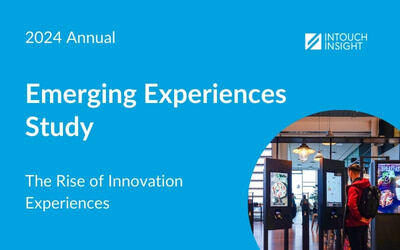2024 Drive-Thru Study: Key Insights from our Annual Report
For 24 years, the Intouch Insight Annual Drive-Thru Study has been the go-to resource for insights into the drive-thru performance of leading...
3 min read
Sarah Beckett October 15, 2024

As the leading benchmark for drive-thru execution standards, this year’s Annual Drive-Thru Study examined a new and rapidly evolving area: the impact of AI on order-taking. We couldn't pass up the chance to dive into how this technology is shaping the future of drive-thru experiences.
From upgrades to point-of-sale (POS) systems to kitchen automation, AI is being used to streamline much more than just drive-thru ordering, making restaurant operations faster and more efficient. Our focus for this article is the impact on drive-thru operations.
While some brands like McDonald's have chosen to take a strategic step back from certain AI initiatives, others are moving forward at full speed.
Checkers and Rally’s were early adopters of Voice AI, rolling it out across all locations. Taco Bell is now launching AI-powered drive-thru tech nationwide with impressive results. Wendy’s is also making waves with its "FreshAI" initiative, emerging as another strong player in the AI-driven revolution - just to name a few.
The data around these improvements is undeniable, pointing to a future where drive-thru experiences are faster, more accurate, and more seamless than ever before.
In addition to our Annual Drive-Thru Study, we recently surveyed over 1,480 North American consumers to explore their views on restaurant technology, particularly AI in drive-thrus.
The findings reveal a gradual acceptance of AI interactions, though successful implementation remains crucial.
Voice AI Technology
While 45% of respondents said they ‘don’t like the idea’ of AI-enabled voice technology for drive-thru orders - slightly better than 47% the previous year - younger consumers are more open to these innovations (33% of those aged 18-44).
Video AI Technology
The survey indicated a slight preference for voice AI over video AI, with 42% of respondents disliking the latter - only a 2% decrease from the previous year.
Again, younger respondents (32% of those aged 18-44) showed more acceptance than older adults (49% aged 45 and above).
Positive AI Experiences
Adoption of AI voice technology remains low, with only 19% of consumers having experienced it.
However, 61% of those who tried it reported a positive experience, suggesting that as QSRs increasingly implement AI, positive feedback from early users can drive broader acceptance and satisfaction in the future.
While you can’t hardly go a day without seeing news about the latest drive-thru transformations, the adoption and roll-out of AI-enabled tech to support drive-thru ordering is still in its early stages.
Our findings from the 2024 Drive-Thru Study show that only 4% of all drive-thru orders evaluated in this study were placed by customers who reported that they knew they were interacting with a voice-AI ordering solution.
However, our results provide a clear indication of the potential positive impact that this technology will have on drive-thry efficiency and performance.
When mystery shoppers noted that they were interacting with Voice-AI technology, we saw a faster total time of 29 seconds compared to the overall average total time of the study.
This data suggests that Voice AI systems can take orders faster than human operators, helping streamline the ordering process.
With AI handling order-taking, employees can focus on preparing and serving guests efficiently, reducing bottlenecks during peak hours. The combination of faster service and improved accuracy leads to happier customers who are more likely to return, enhancing the guest experience.
The results of the Drive-Thru Study indicate that integrating AI into the ordering process can significantly enhance order accuracy, underscoring its potential to elevate customer service quality.
In fact, when shoppers believed they were interacting with Voice-AI, order accuracy soared to 95%, compared to the overall study accuracy of 89%.
Another study echoed these findings, revealing that AI can successfully handle over 90% of orders without human intervention, while the typical accuracy rate for human operators ranges between 80% and 85%.
This boost in order accuracy profoundly impacts the guest experience and overall satisfaction. After all, nobody wants to unwrap a drive-thru order only to find it’s incorrect—especially when they’re probably already a few miles away from the restaurant.
AI is making waves in customer experience by helping increase the average ticket size through data-driven recommendations and effective upselling.
According to the 2024 Drive-Thru Report, AI technology has improved the success rate of suggestive selling by 5%, highlighting its potential to boost revenue significantly.
By leveraging AI, QSRs can personalize customer interactions based on past orders and preferences. This capability allows brands to suggest relevant items and change digital menu boards, enhancing the overall customer experience while increasing ticket sizes through effective suggestive selling.
According to the 2024 Drive-Thru Study, overall satisfaction reached 94%, rising to 98% when shoppers believed they were interacting with Voice-AI.
This highlights the potential of AI to enhance the drive-thru experience and elevate customer satisfaction even further.
In the broader context of quick-service restaurants (QSRs), AI can transform overall guest experiences by streamlining operations, personalizing interactions, and providing valuable insights into customer preferences.
For instance, AI can analyze customer behavior and traffic patterns to optimize staffing, menu suggestions, and service speeds.
This predictive capability enables real-time adjustments that improve efficiency and customer satisfaction. By anticipating demand and proactively managing resources, QSRs can ensure that they meet customer needs effectively, even during peak times.
Whether it’s a human or AI interacting with guests at the drive-thru, what truly matters is the ability to create memorable experiences.
As the quick-service industry evolves, embracing AI will be a game-changer, helping brands shine in a competitive landscape while delivering the experiences they aim for.
The future looks promising for drive-thru experiences. With AI tackling real operational challenges, guests can anticipate faster, more personalized, and genuinely delightful experiences every time they roll through the lane.

For 24 years, the Intouch Insight Annual Drive-Thru Study has been the go-to resource for insights into the drive-thru performance of leading...

The Quick-Service Restaurant (QSR) industry is constantly evolving. Among all the trends influencing how restaurants operate, digital ordering cannot...

The restaurant industry is evolving at an unprecedented pace. Brands are introducing customer-facing technology, new menu items, limited-time offers,...